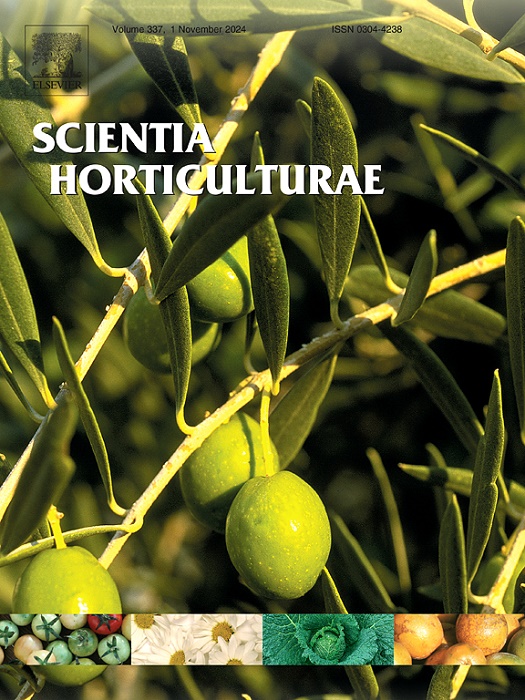在红色和绿色生菜(Lactuca sativa L. var. capitata)上应用连续和脉冲 LED,进行收获前后的质量和能源成本评估
IF 3.9
2区 农林科学
Q1 HORTICULTURE
引用次数: 0
摘要
植物栽培的光照控制是可控环境农业(CEA)的一个重要研究领域,植物工厂、生长室和温室通常会采用各种人工光照条件。为了达到这一目的,对绿色和红色两种莴苣栽培品种采用了两种不同的 LED 处理方法:一种是连续的 LED 处理,其中幼苗阶段的平均光合光通量密度(PPFD)保持在 228 µmole s¯¹ m¯²,光周期为 16 小时,生长周期为 30 天;另一种是动态模式脉冲 LED 处理,脉冲频率设定为 1 kHz,占空比为 50%,光合光通量密度保持在 228 µmole s¯¹ m¯²,光周期为 16 小时,生长周期为 30 天。采收时(T0)取样进行质量评估,冷藏 7 天后(T7)分析采收前使用 LED 的效果。在脉冲 LED 的作用下,两种栽培品种的平均鲜重都有明显下降,而在红莴苣的处理中,叶长有明显增加。两种处理都导致光合色素:总叶绿素和类胡萝卜素的变化不显著,而绿色莴苣的酚指数和花青素产量没有显著差异。然而,在连续使用 LED 的情况下,红生菜在 T0 阶段的酚醛指数明显较高,而在 T7 阶段则明显下降。在绿色生菜中,两种处理和两个时间点的硝酸盐产量没有明显差异;但在红色生菜中,脉冲 LED 在 T0 阶段的硝酸盐产量明显高于连续 LED。在两个时间点上,绿色生菜的总糖含量均无明显变化,而脉冲 LED 处理下的糖含量则显著下降。另一方面,在连续 LED 处理下,红生菜的总糖在两个时间点之间明显下降,而红生菜则没有出现这种变化。同样,在 T0 阶段,绿色生菜和红色生菜的蔗糖都没有明显增加或减少,而红色生菜的蔗糖在不同时间点之间明显减少。对莴苣植株的健康状况进行了非破坏性分析,结果表明,在使用脉冲 LED 的情况下,绿色莴苣在 T0 和 T7 阶段积累的花青素和叶绿素均高于红色莴苣。两种处理的绿色生菜在 T7 时的花青素含量也显著较高。不过,在光系统 II 的光化学最大量子效率(Fv/Fm 比值)和叶片的整体性能指数(PI)方面,不同处理和时间点之间的差异并不显著。这项研究表明,将人工光源从连续式 LED 改为脉冲式 LED 对节约能源成本具有重要意义,同时也为在这种动态模式下保持农产品的质量迈出了一步。本文章由计算机程序翻译,如有差异,请以英文原文为准。
Continuous and pulsed LED applications on red and green lettuce (Lactuca sativa L. var. capitata) for pre- and post-harvest quality and energy cost assessments
Light manipulation for plant cultivation is a critical area of study in controlled environment agriculture (CEA), where a variety of artificial lighting conditions are often employed in plant factories, growth chambers and greenhouses. With this aim of manipulation, two lettuce cultivars, green and red, were treated with two different LED treatments: a continuous LED in which an average photosynthetic photon flux density (PPFD) at the seedling level was maintained at 228 µmole s¯¹ m¯², a photoperiod of 16 h was set for a growing cycle of 30 days, and a dynamic mode pulsed LED treatment with a pulsed frequency set at 1 kHz with a duty cycle of 50 % along with the PPFD at 228 µmole s¯¹ m¯², a 16-hour photoperiod, and a growing cycle of 30 days. Sampling for quality assessment was done at harvesting (T0) and the effect of pre-harvest LED application was analyzed after 7 days of cold storage (T7). A significant reduction in the average fresh weight of both cultivars was seen under pulsed LED while a significant increase in leaf length was noticed among the treatments in red lettuce. Both treatments resulted in non-significant variations for photosynthetic pigments: total chlorophyll and carotenoids, while no significant differences were seen in terms of phenolic index and anthocyanin production in green lettuce. Red lettuce, however, yielded a significantly higher phenolic index for continuous LED at T0, which significantly declined at T7. In green lettuce, nitrate production underwent no significant differences under both treatments and time points; however, pulsed LED in red lettuce yielded significantly higher nitrate than continuous LED at T0. At both timepoints, no marked changes were seen in terms of total sugars in green lettuce, while a significant reduction in sugar was recorded under pulsed LED treatment. On the other hand, a significant decline in total sugars was noticed between the timepoints for red lettuce under continuous LED treatment, while no such variations were seen in red lettuce. Similarly, at T0 both green and red lettuce showed no remarkable increment or decline for sucrose, while it significantly declined between timepoints for red lettuce. Non-destructive analysis was carried out to investigate the health status of lettuce plants where the green lettuce under pulsed LED accumulated higher anthocyanins at both T0 and T7 and higher chlorophyll at T7 than red lettuce under the same LED application. Significantly higher anthocyanins were also seen at T7 between the two treatments in green lettuce. Non-significant differences, however, were found between the treatments and timepoints for both the photochemical maximum quantum efficiency of photosystem II (Fv/Fm ratio) and the overall performance index (PI) of leaves. This research demonstrated the significance of artificial light modification from continuous to pulsed LED to save energy costs and a step forward towards retaining the quality of the produce in this dynamic mode.
求助全文
通过发布文献求助,成功后即可免费获取论文全文。
去求助
来源期刊

Scientia Horticulturae
农林科学-园艺
CiteScore
8.60
自引率
4.70%
发文量
796
审稿时长
47 days
期刊介绍:
Scientia Horticulturae is an international journal publishing research related to horticultural crops. Articles in the journal deal with open or protected production of vegetables, fruits, edible fungi and ornamentals under temperate, subtropical and tropical conditions. Papers in related areas (biochemistry, micropropagation, soil science, plant breeding, plant physiology, phytopathology, etc.) are considered, if they contain information of direct significance to horticulture. Papers on the technical aspects of horticulture (engineering, crop processing, storage, transport etc.) are accepted for publication only if they relate directly to the living product. In the case of plantation crops, those yielding a product that may be used fresh (e.g. tropical vegetables, citrus, bananas, and other fruits) will be considered, while those papers describing the processing of the product (e.g. rubber, tobacco, and quinine) will not. The scope of the journal includes all horticultural crops but does not include speciality crops such as, medicinal crops or forestry crops, such as bamboo. Basic molecular studies without any direct application in horticulture will not be considered for this journal.
 求助内容:
求助内容: 应助结果提醒方式:
应助结果提醒方式:


